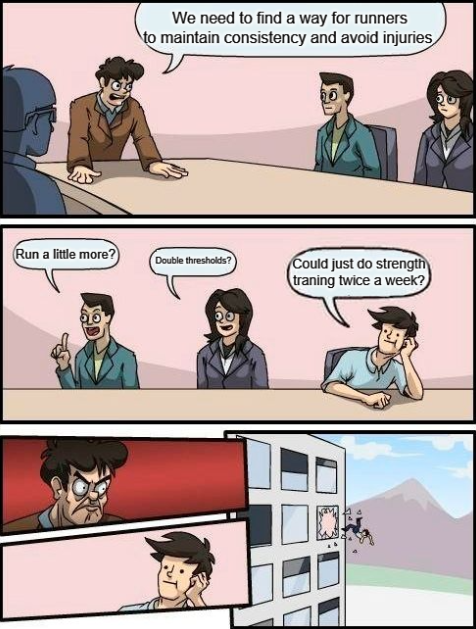Hey there,
I hope your running is going well. This edition of the newsletter features a brand new section. I’m excited to share it with you.
Last week, I asked you to share your best tips for when you can’t run. Thanks to everyone who contributed! I will feature a selection of your responses. Next week. This week, I’ve got a very special story to share for the inaugural edition of the section I’ve dubbed “Runners’ Replies”.
Oh, and since you all asked nicely: Memes are back. Enjoy!
Runners’ Replies
In this week’s Runners’ Replies, I’m sharing a deeply personal story. It comes from Debra M, who reached out to share it with me a while back. For months I let it sit in my inbox, unsure how I could respond in a way that would properly convey how much it moved me.
Debra started her running journey back in 2017, one year after the death of her daughter. At the age of 61, she took it up as a method to cope with the grief of losing a child. It began, as it often does, with a few 5k events. She thought that would be it. However, months later, being drawn back to the physical and emotional aspects of running, she trained and accomplished a 10 mile race. The largest 10 miler in the US, no less!
That accomplishment started her off on a sometimes painful but beautiful journey of running a circuit of memorial races of half marathons and 2 marathons in locations significant to her daughter’s life, to their lives together.
Months after receiving her email, I decided that the only proper way I could respond to her email was to ask if I could share it. Here’s the story she shared with me, that she’s now graciously allowed me to share with you:
I felt ready. Living calmly with my grief now, I felt ready. Ready to run down a new road in my journey; running relaxed, with enjoyment of the moment. So I registered for my third marathon, the first event I would run that was not connected to my daughter. My first international race. A race just over the US – Canada border, but still international. The goal was to run a beautiful race; to run for myself and enjoy the moments through the miles.
I disconnected from social media and ran solo throughout the months of training, not attending my run club runs. Though the group I run with are very supportive souls, solitude was necessary for me to focus on just myself, in both physical and emotional aspects; head, heart, and body.
Training progressed wonderfully. Feeling more calmness than I have before in training without unnecessary pressure. I told my coach up front this is an emotional goal not a pace/time goal race for me. I had no basis for comparisons to others, staying off of social media. Physically I knew I had grown stronger and with it my confidence. Though I had a mild knee issue from the start, it did not hurt during runs. Stiffness and inflexibility were kept at bay with the PT exercises, gentle yoga, strength training, etc. that I was doing. The knee felt fantastic, I felt fantastic, just before taper was to begin. Confident and content I planned a point to point run for my last 20-miler, four weeks from race day.
The run was going along fine at an easy pace and effort, until like a switch flipped the last 9 miles felt to be quite a chore. I pushed through to complete it and was left at the end more stiff and fatigued than after either of my marathons. Odd how my body seemed to snap from an easy flow to an old rusty machine laboring to move. I thought not much more of it, taking the remainder of the day easy to rest.
The following day both the knee and the entire thigh above were unmistakably quite swollen. Sports doctor appointment, fluid drained, corticosteroids injected, and instructions for NO activity for a week. RICE. A week of minimal walking, a week with walk-run short distances, followed then with short runs to race day.
I knew I had done the work in training, I knew my body still retained its ability, but still I lost enthusiasm and confidence, I felt disheartened and deflated. I put trust in believing my confidence and enthusiasm would grow once we reached the destination, a 9+ hour drive away.
On race day, the weather was perfect, the course an interesting run through varied city streets and along the waterfront. I felt relaxed at the start but oddly flat, lacking any real enthusiasm, excitement, or anxiousness. Still, I told myself to trust and be ok with that, thinking it was just my way to maintain a calm and controlled start for the first 2.5 miles, then over the .5 mile hill. Just me being focused on not going out too fast, remaining composed to get over the hill. Thinking and repeating “trust”, over the hill and you’ll be good to go, to settle into progressing to my marathon pace. Long story short, I never was able to get out of the conservative pace that I started with. After a long descent the soles of my feet and toes hurt (I think it was the descent, the pain I later discovered was blisters forming… a first for me). Ignoring the physical discomfort, I knowingly was way off what “should have been” my pace, lacking energy and drive. Underlying the goal of enjoyment in the moment still lay subconsciously the goal to PR. To “measure up”, for validity to myself as a runner, to my coach, to run club members should I post the run publicly on Strava… NONE of this should have mattered. I considered for a moment if I should split off with the half marathoners to their finish line.
Perseverance prevails, I can not quit and thought, “You don’t know what can still happen”. The field drastically thinned with only marathoners. Slowing, I started to feel as I did during my last 20-miler, it was all a chore. I thought to do a few short pickup strides to perk up, but for some reason didn’t even try. Why? I haven’t a clue. Feeling defeated. My mental wall was confronted.
In failure, pain and loneliness run together with me.

Failure evident in the race goal of a beautiful race, of coming close to the PR that I knew I was physically capable of. Failure gives rise to thoughts of the pain and loneliness our daughter harbored, then to the pain and loneliness I harbor. Pain of how I feel I failed her. Loneliness in my struggle to go on; in the race, in life without her. Questioning why and purpose of it all.
Emotions lock the gate to go through my mental wall, as my body reacts, unable to breath as if my throat was swollen, closing the passage for air to flow. This is my marathon wall, the wall I’ve encountered during the three marathons I’ve run. Three times during this race, though shorter in duration pulling out of it more quickly. The first occurrence was accompanied by tears, grief tears – the first time this has happened during any race.
In his response to my text, “It was not my day”, my PT responded, “The tough races build character and you learn the most from them. Tough miles are good miles.” Yes, true. If there is one thing I have come to realize through my running experiences it is that learning comes from every race. From the start of this training cycle through to the finish line I learned a lot!! I learned more about: what works and what doesn’t for me in training; nutrition tweaks throughout training and fueling the race; dealing with injury, disrupted training, and blisters (all firsts); and where I am emotionally along my running journey, in life, and in grief. I have continued to process the nuanced subcategories within each, all aiding to direct me along my path forward.
Trust; “You don’t know what can still happen”. The kicker here is even with the physical, mental, and emotional walls I faced, my race resulted in being 2nd AG, 1:05 minute off a PR (to be just a one second PR) and 2 min off a BQ (at its lowest qualifying time, but still). I need to train to build true internal belief and trust, not just words to say hoping to believe.
So much oddness encapsulated this race. Odd not to feel enthusiasm, excitement, or anxiousness on race morning. Odd to feel absolutely stuck in first gear and not attempting to shift. Odd the tears during a race, and odd how the feelings of grief remained strong for days after, as heavy as grief felt seven years ago when our daughter died. Odd how I read a few days later, quite by chance, that the first Sunday in May is “International Bereaved Mother’s Day”. (I had never heard of it before.) Race day, May 7th, the first Sunday in May this year and my first international race. Odd how life is sometimes.
I hope you found that as moving as I did. Again, thanks to Debra for allowing me to feature her story.
All About Heart Rate Variability and How Tracking It Can Boost Your Training

“The ups and downs of HRV can be so tricky to navigate, in fact, that most doctors, even cardiologists, don’t factor it into treatment plans for their patients. So is it a metric you should start tracking—or one of the bells and whistles on your smartwatch that you should maybe skip over?”
When it comes to data, I’m rarely one to say no. But HRV — which I’ve previously featured several articles on in previous editions of the newsletter — is a bit of a tricky one. This extensive introduction from Runner’s World tells you everything you need to know to make an informed decision about whether it can aid you in planning your training.
Multi-Day Runners Are Alarmingly Sane

“Part of the appeal, he told me, was spending his days with a clear sense of purpose. It was a reprieve from the messy ambiguities of everyday life. “When I do this, I enter into a certain state of mind where everything is crystal clear and I feel this alignment between my thoughts, my physical body, and my emotions. Whereas, in normal life, I feel more distracted,” he says.”
I was ready to file this one away under fake news based on the headline. But Martin Fritz Huber has a lot of goodwill in my book, so I decided to give his take on multi-day ultra runners a chance. He nailed it.
Running in the Cold, Respiratory Health & Raynaud’s

“Before reaching the lungs, the air we breathe must journey through a series of tubes that warm and humidify them. At rest, this task is accomplished quite easily in most people. However, during exercise, when breathing rates increase, the capacity of the “conducting airways” to warm and humidify the air is often exceeded.”
This one’s been sitting in my “to share” folder for a while. And, with the turning of the seasons, it’s time to get it out there. Here you’ll find some clearly explained information on how the cold affects our body during exercise, and what you can do to minimise the negative impact.
Finish Line Funnies
(I asked ChatGPT to come up with a new name for the meme section, and out of 100 suggestions this was the best one. Seriously!)

And that’s all I had to share with you this week. Did you love or hate this edition of the newsletter? Click the relevant link below to share your opinion.
See you again in a week!
Lars-Christian
Did you enjoy this edition of the newsletter?
Let me know by sending me an email at lc@run161.com.
